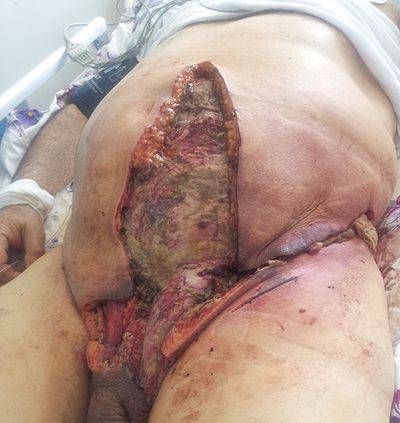Fournier's Gangrene
Fournier's gangrene is a rare but life-threatening condition characterized by necrotizing fasciitis (tissue death due to severe infection) of the perineum, genitals, or surrounding areas. It progresses rapidly and requires immediate medical attention.
---
Causes
Fournier's gangrene is caused by a polymicrobial infection, involving bacteria such as:
Escherichia coli (E. coli)
Klebsiella species
Staphylococcus aureus
Streptococcus species
Clostridium species
Risk factors include:
1. Diabetes Mellitus:
Poor blood sugar control impairs immunity and wound healing.
2. Trauma or Surgery:
Injury to the perineal region or post-surgical infections.
3. Urinary Tract Infections (UTIs):
Especially if untreated or complicated.
4. Compromised Immune System:
HIV/AIDS, cancer, or use of immunosuppressive drugs.
5. Obesity:
Increases vulnerability to infections.
6. Alcoholism:
Associated with malnutrition and poor immunity.
---
Signs and Symptoms
1. Early Symptoms:
Pain, redness, or swelling in the genital or perineal region.
Fever and general malaise.
2. Progressive Signs:
Black, necrotic (dead) skin.
Foul-smelling discharge.
Crepitus (crackling sensation due to gas under the skin).
3. Severe Cases:
Rapid spread of infection.
Signs of septic shock: low blood pressure, rapid heartbeat, confusion, and organ failure.
---
Effects
1. Tissue Necrosis:
Rapid destruction of skin, fat, and fascia.
2. Sepsis:
Systemic infection can lead to multi-organ failure.
3. Disfigurement:
Extensive tissue removal may result in permanent scarring or deformity.
4. High Mortality Rate:
Without prompt treatment, death rates can exceed 20-30%.
---
Solutions
1. Immediate Medical Attention:
Fournier's gangrene is a medical emergency.
2. Treatment Options:
Surgical Debridement:
Removing dead tissue to stop the spread of infection.
Antibiotics:
Broad-spectrum IV antibiotics targeting multiple bacteria (e.g., carbapenems, clindamycin).
Hyperbaric Oxygen Therapy (HBOT):
Increases oxygen to the affected tissues, which inhibits bacterial growth and aids healing.
Supportive Care:
Fluids, vasopressors, and ICU care to manage sepsis.
3. Reconstructive Surgery:
Skin grafts or flaps may be required after the infection is controlled.
4. Management of Underlying Conditions:
Control diabetes, treat UTIs, and address immune deficiencies to prevent recurrence.
5. Post-Treatment Rehabilitation:
Physiotherapy and psychological counseling to cope with the physical and emotional effects.
---
Prevention
1. Control Risk Factors:
Maintain good blood sugar levels in diabetics.
Avoid smoking and alcohol abuse.
2. Proper Wound Care:
Treat and clean perineal injuries or surgical sites promptly.
3. Early Detection:
Seek medical attention at the first sign of pain, swelling, or infection in the genital or perineal area.
4. Good Hygiene:
Maintain cleanliness, especially in people prone to infections.
---
Prognosis
With early diagnosis and aggressive treatment, survival rates improve, and many individuals recover fully. However, delayed treatment significantly increases the risk of complications and death. If you notice signs of Fournier’s gangrene, seek emergency medical care immediately.


